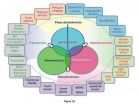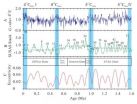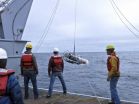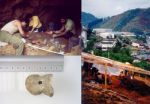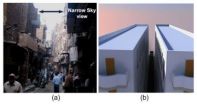(Press-News.org) By tracking brain activity when an animal stops to look around its environment, neuroscientists at the Johns Hopkins University believe they can mark the birth of a memory.
Using lab rats on a circular track, James Knierim, professor of neuroscience in the Zanvyl Krieger Mind/Brain Institute at Johns Hopkins, and a team of brain scientists noticed that the rats frequently paused to inspect their environment with head movements as they ran. The scientists found that this behavior activated a place cell in their brain, which helps
the animal construct a cognitive map, a pattern of activity in the brain that reflects the animal's internal representation of its environment.
In a paper recently published in the journal Nature Neuroscience, the researchers state that when the rodents passed that same area of the track seconds later, place cells fired again, a neural acknowledgement that the moment has imprinted itself in the brain's cognitive map in the hippocampus.
The hippocampus is the brain's warehouse for long- and short-term processing of episodic memories, such as memories of a specific experience like a trip to Maine or a recent dinner. What no one knew was what happens in the hippocampus the moment an experience imprints itself as a memory.
"This is like seeing the brain form memory traces in real time," said Knierim, senior author of the research. "Seeing for the first time the brain creating a spatial firing field tied to a specific behavioral experience suggests that the map can be updated rapidly and robustly to lay down a memory of that experience."
A place cell is a type of neuron within the hippocampus that becomes active when an animal or human enters a particular place in its environment. The activation of the cells
helps create a spatial framework much like a map, that allows humans and animals to know where they are in any given location. Place cells can also act like neural flags that "mark" an experience on the map, like a pin that you drop on Google maps to mark the location of a restaurant.
"We believe that the spatial coordinates of the map are delivered to the hippocampus by one brain pathway, and the information about the things that populate the map, like the restaurant, are delivered by a separate pathway," Knierim said. "When you experience a new item in the environment, the hippocampus combines these inputs to create a new spatial marker of that experience."
In the experiments, researchers placed tiny wires in the brains of the rats to monitor when and where brain activity increased as they moved along the track in search of chocolate rewards. About every seven seconds, the rats stopped moving forward and turned their heads to the perimeter of the room as they investigated the different landmarks, behavior called "head-scanning."
"We found that many cells that were previously silent would suddenly start firing during a specific head-scanning event," Knierim said. "On the very next lap around the track, many of these cells had a brand new place field at that exact same location and this place field remained usually for the rest of the laps. We believe that this new place field marks the site of the head scan and allows the brain to form a memory of what it was that the rat experienced during the head scan."
Knierim said the formation and stability of place fields and the newly activated place cells requires further study. The research is primarily intended to understand how memories are formed and retrieved under normal circumstances, but it could be applicable to learning more about people with brain trauma or hippocampal damage due to aging or Alzheimer's.
"There are strong indications that humans and rats share the same spatial mapping functions of the hippocampus, and that these maps are intimately related to how we organize and store our memories of prior life events," Knierim said. "Since the hippocampus and surrounding brain areas are the first parts of the brain affected in Alzheimer's, we think that these studies may lend some insight into the severe memory loss that characterizes the early stages of this disease."
INFORMATION:
Other authors on this research are: Joseph Monaco, a post-doctoral fellow with the Johns Hopkins Krieger Mind/Brain Institute and the Biomedical Engineering Department at the Johns Hopkins School of Medicine; Geeta Rao, a researcher at the Mind/Brain Institute; and Eric D. Roth, an assistant professor at the University of Delaware.
This research was supported by NIH grants R01 MH094146, R01 NS039456 and P01
NS038310.
Neuroscientists: Brain activity may mark the beginning of memories
2014-04-14
ELSE PRESS RELEASES FROM THIS DATE:
Piezotronics and piezo-phototronics leading to unprecedented active electronics and optoelectronics
2014-04-14
New technologies for developing electronics and optoelectronics with tunable/adaptive functionalities and performance are critical to emerging applications in wearable technology, communication, pervasive computing, human-machine interfacing and biomedical diagnostics, in which the active and adaptive interactions between devices and stimuli from the ambient/host (e. g. human body) are essential. Mechanical stimuli are ubiquitous and abundant in the environment for interacting with or controlling these electronics/optoelectronics. This is, however, not facile to implement ...
Quantum manipulation: Filling the gap between quantum and classical world
2014-04-14
Quantum superposition is a fundamental and also intriguing property of the quantum world. Because of superposition, a quantum system can be in two different states simultaneously, like a cat that can be both "dead" and "alive" at the same time. However, this anti-intuitive phenomenon cannot be observed directly, because whenever a classical measuring tool touches a quantum system, it immediately collapse into a classical state. On the other hand, quantum superposition is also the core of quantum computer's enormous computational power. A quantum computer can easily break ...
New Commission study identifies Europe's top ICT hubs
2014-04-14
Wondering what makes an ICT hotspot? Take a look at Munich, London, Paris or smaller cities such as Darmstadt identified in a new EU Atlas of ICT hotspots. This atlas shows where digital technologies thrive and examines the factors contributing to this success.
Most of Europe's ICT activity takes place in 34 regions across 12 countries (listed in the Annex). Key ingredients to success included access to top Universities and research centres and funding opportunities such as venture capital.
European Commission Vice-President @NeelieKroesEU said: "This is proof that ...
Climate change: The role of oceanic carbon reservoir over glacial cycles
2014-04-14
Glacial cycles at 104-yr time scale have been the focus of Quaternary paleoclimatology over the last century. In recent years with the emergence of continuous high-resolution records (ice cores, deep-sea sediments etc.) from the longer geological past, increasing evidence underscores the significance of long- duration processes at the time scale of 105-yr or more. WANG Pinxian and colleagues from the State Key Laboratory of Marine Geology, Tongji University, reviewed long-term variations in the oceanic carbon reservoir and indicated their crucial role in major climate regime ...
Genetically modified tobacco plants as an alternative for producing bioethanol
2014-04-14
Tobacco, a high-density crop which is mown several times throughout its cycle, can produce as much as 160 tonnes of fresh matter per hectare and become a source of biomass suitable for producing bioethanol. As Jon Veramendi, head of the plant Agrobiotechnology research group, explained, "tobacco plants as a source of biomass for producing bioethanol could be an alternative to traditional tobacco growing which is in decline in the USA and in Europe because it cannot compete with emerging countries like China".
In the course of the research, which has been echoed by the ...
Puget Sound's rich waters supplied by deep, turbulent canyon
2014-04-14
The headwaters for Puget Sound's famously rich waters lie far below the surface, in a submarine canyon that draws nutrient-rich water up from the deep ocean. New measurements may explain how the Pacific Northwest's inland waters are able to support so many shellfish, salmon runs and even the occasional pod of whales.
University of Washington oceanographers made the first detailed measurements at the headwater's source, a submarine canyon offshore from the strait that separates the U.S. and Canada. Observations show water surging up through the canyon and mixing at surprisingly ...
Study links domestic abuse to mental health problems in new mothers
2014-04-14
A new study shows that domestic abuse is closely linked to postpartum mental health problems, including depression and post-traumatic stress disorder (PTSD), in mothers. The research also found that specific types of abuse are associated with specific mental health problems. The work was done by researchers at North Carolina State University, Simon Fraser University and the University of British Columbia.
"We wanted to see whether and how intimate partner abuse – physical, psychological and sexual – influenced postpartum mental health in women, including problems such ...
Neanderthals and Cro-magnons did not coincide on the Iberian Peninsula
2014-04-14
This news release is available in Spanish. Until now, the carbon 14 technique, a radioactive isotope which gradually disappears with the passing of time, has been used to date prehistoric remains. When about 40,000 years, in other words approximately the period corresponding to the arrival of the first humans in Europe, have elapsed, the portion that remains is so small that it can become easily contaminated and cause the dates to appear more recent. It was from 2005 onwards that a new technique began to be used; it is the one used to purify the collagen in DNA tests. ...
Let the sun shine in: Redirecting sunlight to urban alleyways
2014-04-14
WASHINGTON, April 14—In dense, urban centers around the world, many people live and work in dim and narrow streets surrounded by tall buildings that block sunlight. And as the global population continues to rise and buildings are jammed closer together, the darkness will only spread.
To alleviate the problem, Egyptian researchers have developed a corrugated, translucent panel that redirects sunlight onto narrow streets and alleyways. The panel is mounted on rooftops and hung over the edge at an angle, where it spreads sunlight onto the street below. The researchers describe ...
Wolves at the door: Study finds recent wolf-dog hybridization in Caucasus region
2014-04-14
Dog owners in the Caucasus Mountains of Georgia might want to consider penning up their dogs more often: hybridization of wolves with shepherd dogs might be more common, and more recent, than previously thought, according to a recently published study in the Journal of Heredity (DOI: 10.1093/jhered/esu014).
Dr. Natia Kopaliani, Dr. David Tarkhnishvili, and colleagues from the Institute of Ecology at Ilia State University in Georgia and from the Tbilisi Zoo in Georgia used a range of genetic techniques to extract and examine DNA taken from wolf and dog fur samples as well ...
